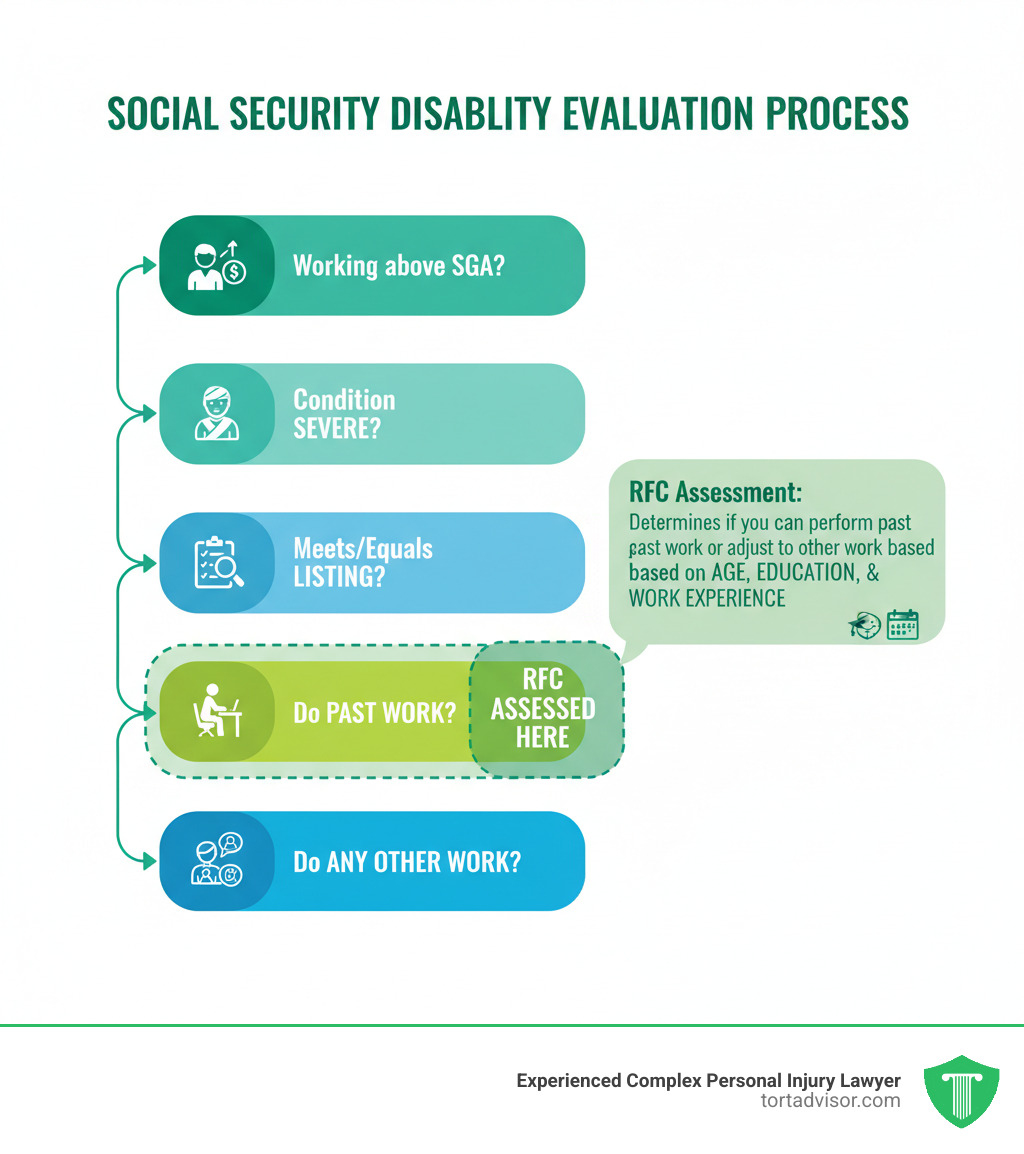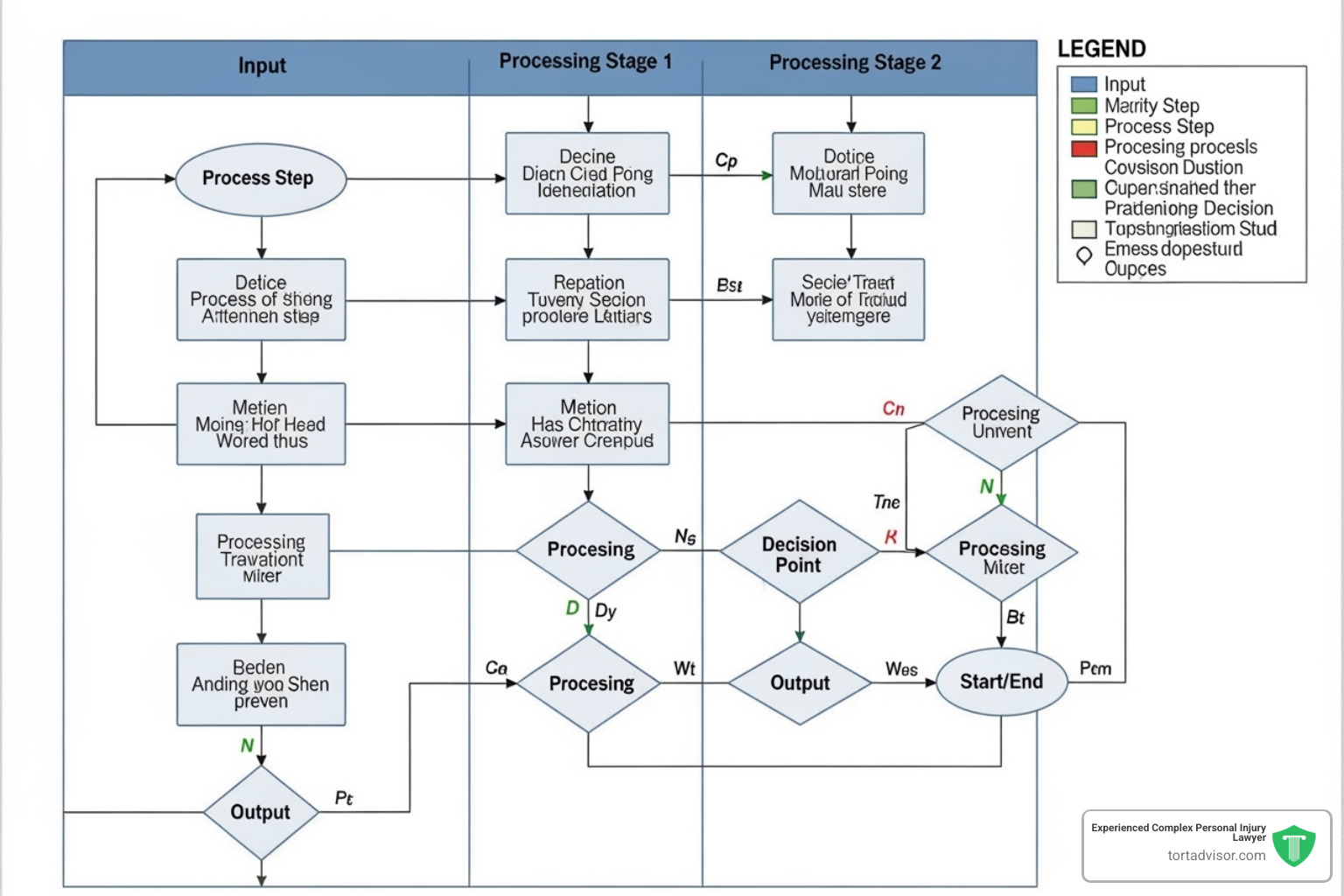


Understanding Your Work Abilities After a Disabling Injury
Residual functional capacity (RFC) is the Social Security Administration’s (SSA) assessment of what you can still do in a work setting despite your physical or mental limitations. It’s not a medical diagnosis, but an administrative tool used to measure your maximum ability to perform work-related activities on a sustained basis (8 hours a day, 5 days a week). The SSA, not your doctor, makes the final determination.
This assessment considers all your impairments and symptoms, like pain, to evaluate your physical and mental capabilities. Your RFC is critical because it’s used in steps 4 and 5 of the disability evaluation process and can be the difference between your claim’s approval and denial.
If a personal injury prevents you from working, understanding your RFC is essential. The SSA focuses on what you can still do, assessing everything from lifting capacity to concentration and environmental restrictions (like exposure to dust or fumes).
For example, SSA regulations note that two people with the same back disorder might have different RFCs; one might be capable of medium work, while the other, due to pain, is limited to light work.
I’m Mason Arnao. My background in navigating complex data systems and regulatory frameworks provides a unique perspective on how the SSA processes Residual functional capacity assessments. In this guide, I’ll simplify the RFC process so you can understand what the SSA evaluates and how to strengthen your claim.

Residual functional capacity definitions:
- Denied Disability Claim
- Disability Claim Assistance
- How to Claim Social Security Disability Insurance Arkansas
What is Residual Functional Capacity (RFC)?
Residual functional capacity is the Social Security Administration’s specific measure of what you can do in a work setting despite your health conditions. It’s not a simple “disabled” or “not disabled” label; it’s a detailed evaluation of your abilities, like whether you can lift 20 pounds or stand for six hours.
A key concept is your ability to work on a sustained basis. The SSA wants to know if you can perform tasks for a full-time schedule—8 hours a day, 5 days a week—not just on a good day. The formal definition describes RFC as “what an individual can still do despite their limitations,” focusing on how your impairments restrict work-related activities.

Crucially, your RFC is an administrative assessment, not a medical diagnosis. Your doctor diagnoses your condition, but the SSA interprets how that condition affects your ability to work. While your doctor’s opinion is important, the SSA makes the final RFC determination.
The assessment must consider the total limiting effects of all your impairments, including those not considered “severe” on their own. For example, back pain combined with migraines and anxiety might make sustained work impossible, even if each condition alone would not. The SSA is required to evaluate how all your health problems, even minor ones, collectively limit your ability to hold a job.
For the official regulatory language, you can check out Your residual functional capacity in the SSA’s Code of Federal Regulations.
The Comprehensive RFC Assessment Process
The SSA evaluates your Residual functional capacity by building a complete picture of your work capabilities. This process involves gathering evidence from multiple sources, including your medical records (diagnoses, treatment notes, lab results) and, importantly, your doctor’s opinions.
The SSA also values “lay evidence”—statements from you, your family, and former employers that describe your limitations in real-world terms. Your own statements about your symptoms and daily activities are critical, as you are the one living with the impairments.

Once all evidence is collected, a claims examiner, often with a medical consultant, reviews everything to identify your functional limitations. They create a “narrative discussion” that analyzes the evidence, explains inconsistencies, and details how symptoms like pain or fatigue affect your ability to work on a sustained basis. The RFC assessment must be function-by-function, specifying exactly what you can do (e.g., how much you can lift, how long you can stand, whether you can concentrate).
Understanding Exertional Levels
The SSA classifies your physical capabilities using “exertional levels,” which define jobs based on strength requirements. Your RFC will be assigned one of these levels.
- Sedentary work: Lifting no more than 10 pounds. Primarily sitting, with no more than 2 hours of standing or walking in an 8-hour day.
- Light work: Lifting up to 20 pounds occasionally and 10 pounds frequently. Involves significant walking or standing (up to 6 hours a day).
- Medium work: Lifting up to 50 pounds occasionally and 25 pounds frequently. Standing or walking for up to 6 hours.
- Heavy work: Lifting up to 100 pounds occasionally and 50 pounds frequently.
- Very heavy work: Lifting over 100 pounds occasionally and over 50 pounds frequently.
This classification is crucial for determining if you can perform past work or adjust to new jobs.

Assessing Non-Exertional and Environmental Limitations
Your work ability isn’t just about strength. The SSA also assesses non-exertional limitations:
- Postural limitations: Restrictions on bending, stooping, crouching, kneeling, or climbing.
- Manipulative limitations: Difficulties with reaching, handling objects, or fine finger movements (e.g., due to arthritis or carpal tunnel).
- Visual and communicative limitations: Impairments in seeing, hearing, or speaking that affect job performance.
- Environmental restrictions: The need to avoid certain environments, such as dust or fumes for someone with asthma, loud noises for migraine sufferers, or dangerous machinery for those with epilepsy.
The SSA must consider all these specific abilities when determining your Residual functional capacity, as each one narrows the range of jobs you can do.
How Mental Residual Functional Capacity is Determined
Your mental and emotional capacity is equally important. The mental Residual functional capacity assessment evaluates how your mental health conditions affect your ability to function at work.
The SSA examines four key areas:
- Understanding and memory: Can you remember and follow simple or complex instructions?
- Sustained concentration and persistence: Can you maintain focus for extended periods (e.g., two-hour stretches) and complete a normal workday?
- Social interaction: Can you interact appropriately with supervisors, coworkers, and the public?
- Adaptation: Can you handle workplace stress and adapt to changes in a routine work setting?
Severe limitations in these areas can significantly increase your chances of approval. For example, if you are unable to work without complete isolation or would be absent more than one day per month, you may be found disabled. If you’ve faced a Denied Disability Claim due to mental health, a detailed mental RFC is key to a successful appeal.
The Role of Pain and Other Symptoms
Evaluating subjective symptoms like pain, fatigue, and dizziness is a challenging but critical part of the RFC assessment. These symptoms can be debilitating even if they don’t appear on objective medical tests.
The SSA must consider how your reported symptoms limit your ability to perform work activities on a sustained basis. The key is consistency. The SSA will look for a coherent picture across all evidence: your medical records, your doctor’s reports, your prescribed treatments, and your own statements about daily activities.
The more consistent your reported symptoms are with the objective evidence, the more weight they will carry in your RFC assessment. Don’t downplay your pain or other symptoms; these details can be decisive for your claim. For more information, you can review resources like Information on chronic pain from MedlinePlus.
How RFC Determines Your Disability Claim
Your Residual functional capacity assessment is the linchpin of your disability claim, used by the SSA at two critical stages: Step 4 and Step 5 of their evaluation process. After establishing you have a severe impairment that doesn’t meet a listing, the SSA uses your RFC to determine if you can still work.

Step 4: Can You Do Your Past Relevant Work?
At Step 4, the SSA compares your Residual functional capacity to the demands of your “past relevant work” (jobs held in the last 15 years). They consider both how you actually performed the job and how it is generally performed nationwide. If your RFC shows you can still perform your past work in either capacity, your claim will be denied. If your limitations prevent you from doing your old jobs, your claim moves to Step 5.
For those wondering about potential benefit amounts, you might find the SSDI Benefit Calculator helpful for planning purposes.
Step 5: Can You Do Any Other Work?
At Step 5, the SSA considers if you can perform any other work that exists in the national economy. This is where your RFC is combined with your age, education, and work experience. The SSA uses the Medical-Vocational Grid Rules (the “Grids”) to make this determination.
The Grids acknowledge that it’s harder for older individuals with limited education and non-transferable skills to switch to new types of work. For example, a 55-year-old construction worker with a high school diploma, now limited by their RFC to sedentary work, would likely be found disabled under the Grids. This is because it’s considered unrealistic to expect them to transition to an office job. In contrast, a younger person with a college degree and the same RFC might be denied, as they are presumed to have more transferable skills and adaptability.
A well-documented RFC that accurately reflects all your limitations is essential to winning your case at this step. If you need help, Disability Claim Assistance can connect you with professionals who understand this process.
Strengthening Your Case: The Role of Your Doctor and Legal Counsel
A well-documented Residual functional capacity assessment is the foundation of a successful disability claim. While the SSA makes the final RFC decision, they are required to give special consideration to opinions from your treating physicians, known as a Medical Source Statement (MSS).
If your doctor provides a detailed opinion that is well-supported by medical evidence and consistent with your file, the SSA may give it “controlling weight,” meaning they must accept your doctor’s assessment. This makes your doctor’s input one of the most powerful pieces of evidence in your claim.

Getting Your Doctor’s Help with Your Residual Functional Capacity
Your treating physician understands how your condition affects you over time, which a one-time SSA examiner cannot. However, doctors don’t automatically provide detailed functional assessments. You must be proactive.
Schedule an appointment specifically to discuss your work-related limitations. Bring a physical or mental RFC form for your doctor to complete. These forms guide your doctor to provide the specific, function-by-function details the SSA needs. Vague statements like “patient is disabled” are useless. Instead, the form should specify limitations like “can lift no more than 10 pounds” or “can only concentrate for 15-minute intervals.” A detailed, specific assessment from your doctor is difficult for the SSA to ignore.
Why Legal Assistance is Crucial
The Social Security disability system is notoriously complex. An experienced disability attorney understands the SSA’s regulations and knows what they look for in an RFC assessment.
A lawyer can help you:
- Review your medical records to identify gaps.
- Work with your doctors to obtain strong Medical Source Statements.
- Ensure your RFC reflects all your limitations, including pain and fatigue.
- Challenge an inaccurate RFC assessment from the SSA during an appeal.
Claimants with legal representation have significantly higher success rates, especially on appeal. Most disability attorneys work on a contingency basis, meaning you pay nothing unless you win. Given the complexity of the RFC process, professional guidance is often the key to approval. For support, consider reaching out for Disability Claim Assistance from qualified legal professionals.
Frequently Asked Questions about Residual Functional Capacity
Can my RFC change over time?
Yes, your Residual functional capacity can change. The SSA knows that medical conditions can improve or worsen. If your condition deteriorates, a new RFC assessment can strengthen your claim. If it improves, it could affect your continued eligibility. The SSA conducts Continuing Disability Reviews (CDRs) to check for changes. The frequency of CDRs depends on whether your condition is expected to improve. It’s vital to continue seeing your doctors and maintain thorough medical records.
What if the SSA’s RFC assessment is wrong?
If you believe the SSA’s Residual functional capacity assessment is inaccurate, you have the right to appeal. This is common. An appeal allows you to submit new evidence and have your case reviewed by an Administrative Law Judge (ALJ). Many claims are won at the hearing level, where you can explain your limitations in person. An attorney can help you identify errors in the initial assessment and build a stronger case for your appeal. Don’t give up if you are initially denied.
Does a “sedentary” RFC guarantee I’ll get benefits?
No, a sedentary RFC does not guarantee approval, but it significantly improves your chances. The SSA still considers your age, education, and work experience (your vocational factors). For younger individuals with transferable skills, the SSA may find they can adjust to a sedentary job. However, for individuals over 50 with a history of physical labor and limited education, a sedentary RFC often leads to an approval under the Medical-Vocational Grid Rules. These rules recognize that it is harder for older workers to transition to entirely new types of work.
Conclusion: Navigating Your Disability Claim with a Clear RFC
Your Residual functional capacity is the most critical factor in your disability claim. It is the SSA’s answer to the question, “What can you still do despite your limitations?” A successful claim depends on a carefully documented RFC that details every physical and mental limitation, including symptoms like pain and fatigue.
The process is complex, involving detailed medical evidence and an understanding of SSA regulations. This is why proactive steps are essential. Work with your treating physician to get a detailed opinion on your functional limits, and gather comprehensive evidence to support your claim.
But here’s the reality: the disability claims process is deliberately complex. At Tort Advisor, we understand what’s at stake. Your disability claim isn’t just paperwork—it’s your livelihood, your future, and your family’s security. That’s why we connect clients with top-rated specialty attorneys who have proven track records in SSDI cases. They understand the intricacies of Residual functional capacity assessments and know exactly how to present your case for the best possible outcome.
Don’t steer this complex process alone. With the right documentation and skilled legal representation, you can present the strongest possible case for your disability benefits. Your future deserves that level of commitment.
Find expert legal help for your SSDI Lawsuits.
Free Confidential Case Evaluation
Complete the short form below to get an immediate FREE case review with an expert in your specific claim. Don't wait, your case could be time sensitive to file a claim.
Related Posts
After a rideshare assault, an uber sexual assault lawyer guides you to justice, protects your rights, and holds Uber accountable.
Understand Depo-Provera severe side effects, from bone loss and DVT to meningioma. Learn risks, symptoms, and legal options.
Used Depo-Provera & have meningioma? Discover your Depo-Provera lawsuit eligibility & claim compensation.
Understand Residual functional capacity & how it impacts your disability claim. Learn assessment, steps, and how to strengthen your case.
Injured in a truck accident? Find a trusted truck injury lawyer near me. Get expert help to navigate complex claims & win fair compensation.
Understand car accident lawsuits. Explore the legal process, types of compensation, and when to hire an attorney.





